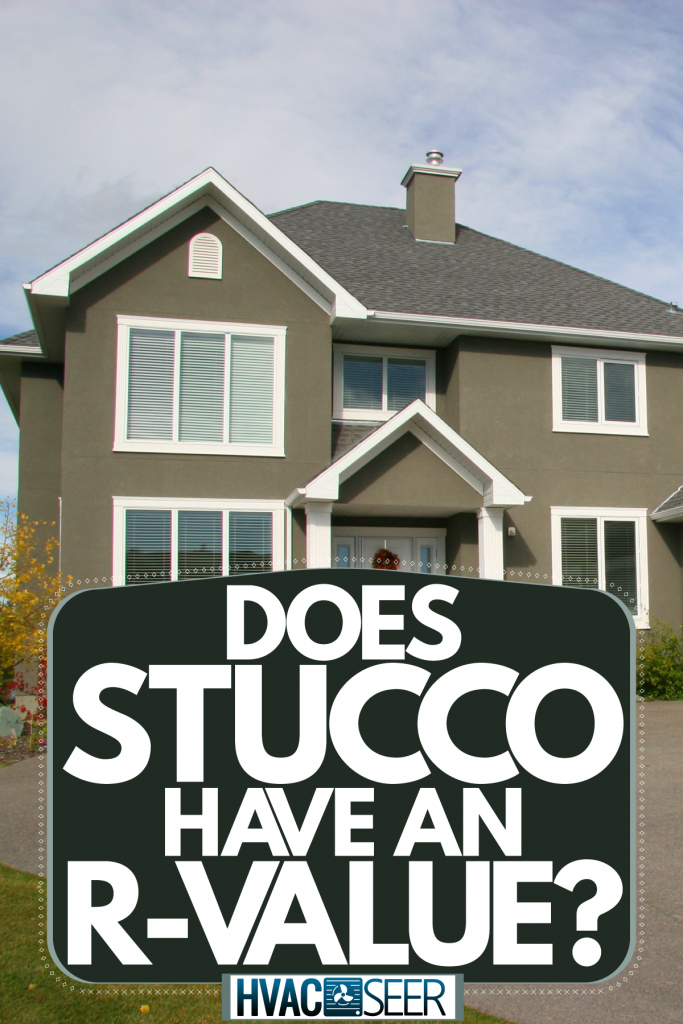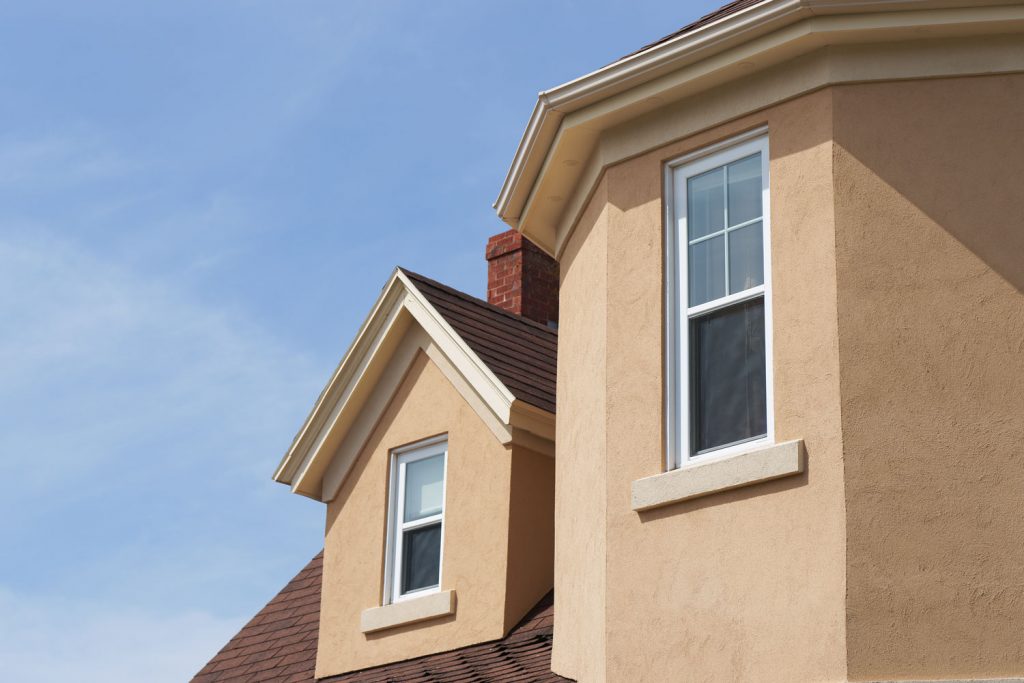You are thinking of remodeling or building a new home and want to consider options such as stucco. You are probably wondering whether stucco has an appropriate R-value to keep your home properly insulated. We will give you the details you want to know. Keep reading to learn more.
Stucco has an R-value of .2 per inch. This is 20 percent of the value that one inch of wood provides. This is a similar R-value to cement mortar and brick but has less than a quarter of the insulative properties of drywall.
Stucco can provide an excellent decorative coating to your home but does not provide a high amount of insulative value. Compared to other construction materials that are applied to wall surfaces, stucco is similar. You may wonder whether you can insulate over stucco and how much it would cost to stucco a whole house. Maybe you have heard good things about stucco and want to know about the benefits and downsides of using stucco in your construction project. This post will give you all the details.

Does Stucco Have An R-Value?
The R-value of stucco is .2. This indicates that it has 20 percent of the insulative properties of wood with the same thickness. We will take a look at the R-value of other materials for the sake of comparison.
- Brick - 0.2
- Cement - 0.2
- Drywall - 0.9
- Hardwood - 1
- Stone - 0.4
- Stucco - 0.2
- Vinyl Siding - 0.6
Stucco has an R-value that is the same as cement mortar and brick. Drywall and wood will give you the most insulative value for inside walls, but stucco could be applied over the top of these other materials. Vinyl siding offers an R-value of 0.6, which is three times the value of stucco as a siding for the house's exterior. It is also possible to apply stucco and siding to the outside of the home to increase the overall R-value.
Stucco does not offer an impressive R-value that would convince you to use this material in your construction, but there are other benefits to using stucco in your home projects. If you find that stucco is a good choice for one of the other benefits it provides, then it will also provide you with a small but significant increase in insulative value. People may choose to use stucco because it is a beautiful finish and has a long lifespan.
How Long Will Stucco Last?
Stucco has a long lifespan that can be 50 to 80 years. Stucco requires very little maintenance and is easy to clean. There are some possible difficulties that may arise from having a stucco finish on your home. If the home foundation settles or moves, it might cause hairline cracks or larger cracks in your stucco finish. There are ways to prevent your foundation from shifting. You can install gutter systems to direct water away from the foundation of the home. This will help to prevent any foundation movement that might cause your stucco finish to crack.

Vinyl siding lasts 20 to 40 years, which is about half the lifespan of stucco. Drywall lasts 25 to 50 years, which is also about half the lifespan of stucco. If you're looking for the finishing material that requires the least amount of maintenance, then stucco is the best option. This is for the interior and exterior of your home if you live in a climate that supports outdoor stucco.
Dap All Purpose Ready To Use Stucco 1 Quart
Click here to buy Dap All Purpose Ready to Use Stucco at Amazon.
Can You Insulate Over Stucco?
It is possible to insulate over a stucco finish. If the stucco is on the interior, you can anchor 1x4 boards through the stucco to the underlying surface. You can fill it with rigid foam insulation. A new layer of stucco could be applied on top of the insulation. The Office of Energy Efficiency & Renewable Energy has detailed guidelines and best practices for completing this project.
If the stucco finish is on the home's exterior, you can add more insulative value by adding another layer of stucco. You can also add siding over the existing stucco, which will have some more insulative value. This will require the use of furring strips. The most common ways of adding insulation to stucco walls are blown insulation or removing the layer of stucco to install foam insulation.
For more information about the cost and effectiveness of blown-in insulation, check out "Is Blown-In Insulation Cheaper Than Rolls?"
How Much Does It Cost To Stucco A House?
It costs an average of $6 to $9 per square foot of stucco, including materials and application. A 1,500 square foot house would cost between $8,000 and $11,000 to stucco completely. Vinyl siding costs about $3.50 per square foot, while brick siding will cost $15 to $28 per square foot for materials and installation. Drywall costs $2 per square foot, so it is a significantly cheaper option for finishing the interior of your home.

Stucco Designs
One of the excellent benefits of stucco is that you can create unique designs and patterns on the walls of your home. Some of these designs are just textured, but you can create pieces of artwork while applying the stucco. If you want to apply the stucco yourself, then getting a hopper gun will be beneficial for your project. This will increase the speed at which you can complete the project and make it easier to create textured designs onto your walls.
If you're interested in completing a beautiful finish, you should check out examples of stucco finishing designs and techniques. It is also helpful to review prior to choosing your stucco finish, so you can get details about the texture of these finishes and how you can achieve them.
Joywayus Air Stucco Cement Hopper Sprayer
Click here to buy the Joywayus Air Stucco Hopper Sprayer at Amazon.
Stucco Benefits
While stucco doesn't have a good R-value compared to other building materials, it does have some benefits that other materials will not provide. One inch of stucco will provide a fire rating of one hour. This means that it will take fire at least one hour to reach the other side of the wall if there is one inch of stucco. Perhaps this benefit alone is worth protecting your house and family from fire damage.
Stucco is easy to clean and maintain. Water and a cloth can wipe off any spots or residue that become affixed to your stucco finish. You have the ability to create a unique, beautiful finish during the application process. Stucco is a material that can last over 100 years but is always expected to last 50 to 80 years at a minimum.
In Closing
Stucco has many benefits if you choose to use it on your home's interior or exterior. If you are looking to get a material with a high R-value as plaster or siding, then stucco is not the best choice. It does have an R-value of .2, which is 20 percent the insulative value of wood. Vinyl siding provides the best insulative value per inch of material compared to alternative siding options. It is possible to stack your materials by adding siding on top of stucco or applying stucco to drywall. Doing this will add to the insulative value of your home.
For more information about ways to better insulate your home by using curtains, visit "Do Curtains Provide Insulation?"


